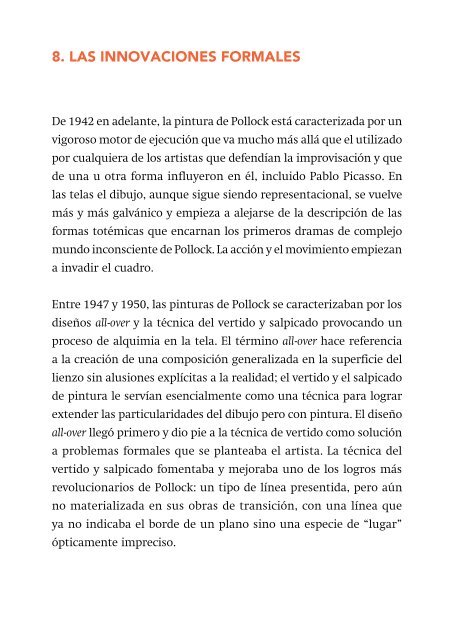MURAL JACKSON POLLOCK
cuadernillo_Jackson_Pollock
cuadernillo_Jackson_Pollock
You also want an ePaper? Increase the reach of your titles
YUMPU automatically turns print PDFs into web optimized ePapers that Google loves.
8. LAS INNOVACIONES FORMALES<br />
8. FORMAL INNOVATIONS<br />
De 1942 en adelante, la pintura de Pollock está caracterizada por un<br />
vigoroso motor de ejecución que va mucho más allá que el utilizado<br />
por cualquiera de los artistas que defendían la improvisación y que<br />
de una u otra forma influyeron en él, incluido Pablo Picasso. En<br />
las telas el dibujo, aunque sigue siendo representacional, se vuelve<br />
más y más galvánico y empieza a alejarse de la descripción de las<br />
formas totémicas que encarnan los primeros dramas de complejo<br />
mundo inconsciente de Pollock. La acción y el movimiento empiezan<br />
a invadir el cuadro.<br />
Entre 1947 y 1950, las pinturas de Pollock se caracterizaban por los<br />
diseños all-over y la técnica del vertido y salpicado provocando un<br />
proceso de alquimia en la tela. El término all-over hace referencia<br />
a la creación de una composición generalizada en la superficie del<br />
lienzo sin alusiones explícitas a la realidad; el vertido y el salpicado<br />
de pintura le servían esencialmente como una técnica para lograr<br />
extender las particularidades del dibujo pero con pintura. El diseño<br />
all-over llegó primero y dio pie a la técnica de vertido como solución<br />
a problemas formales que se planteaba el artista. La técnica del<br />
vertido y salpicado fomentaba y mejoraba uno de los logros más<br />
revolucionarios de Pollock: un tipo de línea presentida, pero aún<br />
no materializada en sus obras de transición, con una línea que<br />
ya no indicaba el borde de un plano sino una especie de “lugar”<br />
ópticamente impreciso.<br />
From 1942 onwards, Pollock’s painting is characterised by a<br />
vigorous execution that goes far beyond that of any of the artists<br />
who defended improvisation and influenced him in one way or<br />
another, including Picasso. While the line on his canvases is still<br />
representational, it becomes more and more galvanic and starts to<br />
depart from the totemic forms that incarnate the primeval dramas<br />
of Pollock’s complex unconscious world. Action and movement<br />
start to invade his pictures.<br />
Between 1947 and 1950, Pollock’s paintings are characterised by<br />
“all-over” designs and by the technique of dripping and splashing,<br />
triggering an alchemical process on the canvas. The term ‘all-over’<br />
refers to the creation of a general composition on the surface of<br />
the canvas with no explicit allusions to reality. The splattering<br />
and dripping of paint served him essentially as a technique for<br />
extending the peculiarities of drawing to painting. The ‘all-over’<br />
design came first, leading to the dripping technique as a solution<br />
to formal problems confronting the artist. The technique of<br />
dripping and splashing aided the development and improvement<br />
of one of Pollock’s most revolutionary achievements: a kind of<br />
sensed but not yet materialised line, a result of transitional works<br />
where line no longer indicated the edge of a plane but a sort of<br />
optically imprecise “place”.


